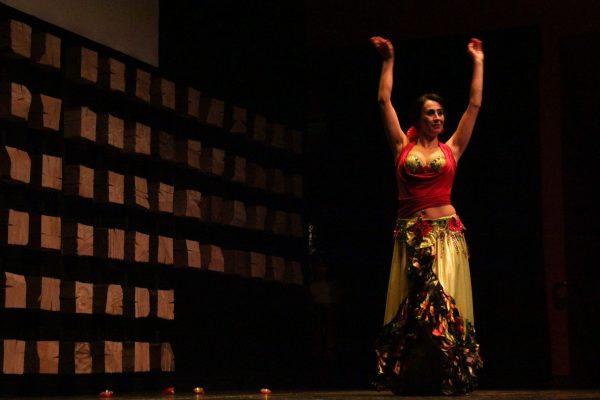
The Republic of Turkey is about as far as you can travel from Alaska on the other side of the globe. The country of nearly 80 million people straddles the edges of Europe and Asia, with a Mediterranean climate, and a rich history as the seat of both the Byzantine and Ottoman Empires. Again, not a lot of parallels with Alaska. But both places have food and dance at the center of their cultural traditions.
At the Wildberry Theater in Anchorage on a recent Saturday night, Engin Kılıç sharpened a long knife next to leg-sized cone of meat rotating near a flame.
“Makes it sharper,” he explained. “Gets dull very easily.”
Kılıç (who’s last name means ‘sword’ in Turkish) was slicing thin strips of meat and heaping it onto pillowy flatbread. It’s a dish called döner, which is was once just an inexpensive street food — almost like the Turkish equivalent of a hot-dog cart– but has spread around the globe and become ubiquitous in world capitals. The meat here is layers of beef and lamb pressed together and marinated for a full day.
“As it cooks, as you can see, its dripping. All that fat is dripping, so it keeps the whole meat very moist,” Kılıç said.
Cooking döner is a bit of a kitchen hobby for Kılıç, who taught himself out of curiosity. He plated the food up as part of a sold-out cultural event called Tables of Istanbul. It’s an evening of food, belly dancing and a documentary by a sociology professor.
“If someone had told me 23 years ago that one day I would live in Alaska, I would never have believed them,” said the film’s narrator, Prof. Zeynep Kılıç, as the screening began.
Kılıç grew up in Ankara, but got her doctorate in the U.S. A few years ago, she moved to Anchorage for a job at UAA, in part to be closer to her brother Engin — the same amateur chef slicing döner. In the film, “Tables of Istanbul,” Professor Kılıç uses her own experience as an immigrant missing Turkish cuisine as doorway into examining the country’s phenomenally complex culinary traditions.
“I just realized that my scholar self was a very critical … like, ‘food imperialism,’ and ‘racialization of ethnic food,’” Kılıç tossed out. “Then my regular self in the kitchen was like, ‘I eat baklava, yay!’”
For years, Kılıç would invite friends over and cook. People would often ask questions about the foods she was making. So she’d give an answer.
“And then there was all this, like, ‘oh my god, I’m telling people all this stuff about Turkish cuisine, but I don’t know anything about it.’ I just know what my mom showed me,” Kılıç laughed. “People treat as if your word is the last word if you’re the only Turkish person they know.”
Her film looks at restaurants and foods around Istanbul, Turkey’s enormous cultural capitol. Kılıç looks at the historical and class dimensions of different foods, and where they fit into the ways people come together to eat. The setting is Turkey, but it’s the kind of curiosity and awareness about food she believes can be applied anywhere.
“It’s not just about Turkish food, if anybody around the table can start thinking about ‘what does my table represent?’ Is this about me being Jewish and eating Kosher food? Or is this about me being Muslim and eating halal food? Or is this about being Alaskan and eating the fish that I fished last summer?” Kılıç posed. “I think these are universal questions.”
After the documentary ended, there was a second round of belly-dancing. In an elaborate costume with colorful, swirling veils, jangling metal talismans, and flashes of bare flesh, the main dancers’ hips ricocheted back-and-forth in time with a rapid drum. It was like watching the choreography to a music video, but with muscle movements one might not even know existed.
The performance was led by Rabia Duddy, who arrived in Anchorage in 2002 after growing up and studying dance in Turkey.
“It’s not a burlesque, it’s not a ballet,” Duddy said of belly-dance. “It’s a truly phenomenal dance form…you become a live instrument on stage.”
Like a lot of immigrants, Duddy acutely missed the things that were common place in her home culture. As a response, she made a little sliver of Anatolia in Anchorage teaching belly-dance, which was a challenge. For example, figuring out how to put highly specific bodily movements into language — a different language, no less.
“Omuz atma,” Duddy offered, as an example, “meaning shoulder shimmy. Or shoulder accent. It took a while.”
Duddy estimates there are about 50 Turks in Alaska, mostly in Anchorage, and she knows the majority of them. In 2013, she decided to undertake a personal initiative, and began organizing events to bring Turks together and expose more people in Alaska to Turkish culture.
This particular night is bitter sweet: it’s one of the last gatherings Duddy is putting on before she and family move out of state this summer.
“It’s emotional” Duddy said. She’d like to see the community she’s helped bring together continue convening for celebrations and special occasions. “I’m hoping (they) continue to have gatherings like this.”
For now though, as guests filed out and the last desserts were scraped from their trays, Duddy felt accomplished with how many people came to eat, learn, and watch a little belly-dancing.
